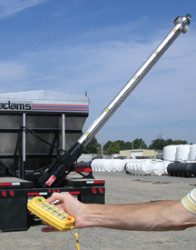Tweaking Tenders

Flush with some cash thanks to higher crop production and prices, fertilizer dealers and growers are looking to upgrade their tenders and nurse tanks in 2008, says Ron Lager, sales manager, Precision Tank & Equipment Co. Units available this year are built for even larger capacities and come with great features that will make dealers’ jobs easier when time is tight.
Michael Sosebee, sales and service expert at Chandler Equipment Co., adds that with recent good corn prices, growers will be able to spend more on many inputs such as granular fertilizer. This helps the entire fertilizer equipment market, especially the large semi-trailer tenders.
Bob Mills, sales manager at Ray-Man, Inc., agrees: “With higher fuel costs the trend is definitely towards larger capacity truck tenders and semi-trailers. It is just more economically feasible to haul 18 to 25 tons per trip than 12 tons. We are already taking orders for next fall and I don’t see things dropping off anytime soon.”
The “bigger is better” mindset can also be seen in nurse tanks, with a trend toward the 4,300 and 5,200 gallon tank sizes, points out Lager.
Mills adds that variable-rate and two- to four-bin applicators have driven the demand for more separate compartments on tenders to support all the different products applied, such as micronutrients.
Going Custom
And while larger units gain attention, “we’re also seeing strong demand in smaller tenders as retailers are purchasing units to service niche markets that require feature-specific units,” says Jon Simonsen, manager of Simonsen Industries.
Indeed, options and customization seem to be the order of the day for tenders. “We continue to round out our line of tenders to include different compartment sizes, drive systems, etc.,” he explains. “We often will build a single unit with special features to fit the needs of only one business.” One of the company’s latest features is a new drive system for its BFT tender line of side and top auger tenders. The drive is an 85 hp self-contained Cummins turbo diesel.
“Longer augers are becoming the norm as larger flotation and row crop combination applicators are being used,” says Chris Lund, marketing communication manager, AGCO Application Equipment. His firm offers long auger options on both its rear and side discharge units.
Adams Fertilizer Equipment’s Double Shot Side Auger Trailer Tender can discharge product from either the right or left sides. “It’s something that many of our customers have requested for some time,” says Michael Tibbett, sales manager at Adams. The feature makes operators more efficient in the field: “If you’re going to load off of a road or out of a field, the Double Shot makes that easier because you don’t have to turn the unit around to do so,” he says.
What Manufacturers Face
Behind the scenes, companies are facing a number of challenges.
Steel. While 409 steel prices have been fairly steady, “304 stainless steel hit record highs this past summer. 304 started to go down a little, but it is going up this winter,” says Mills.
Fuel. “Everybody is on a relatively level playing field when it comes to higher fuel costs, but I don’t believe higher prices will have the effect on tenders themselves as they will on the fertilizers they haul,” says Simonsen.
Devaluation of U.S. dollar. “With the dollar devaluation, we have been seeing pressure on component parts — such as bearings, rubber products, paint, etc. — that are susceptible to exchange rates,” says Simonsen.
Production costs. Manufacturers work hard to avoid passing along costs to buyers. “We have been looking at new ways to improve our production without changing the quality of our equipment,” says Chandler’s Sosebee. “We have already implemented several new production procedures and are looking at others in the future.”
Price tag aside, dealers need tenders. “Growers still need to spread fertilizer and the best way to keep a spreader going is with a tender, so the spreader can stay in the field longer and be more productive,” says Sosebee.





